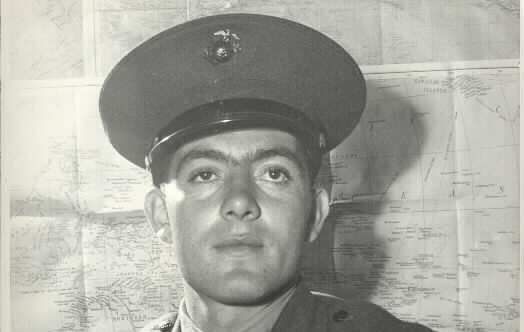In the middle of Little Italy, in downtown San Diego, stands a sunny piazza with a constantly running, beautiful water fountain. In the front of the piazza a severe, bronze casting of an unforgettable hero overlooks the piazza. The hero is John Basilone, a United States Marine Gunnery Sergeant who received the nation’s highest military award for valor, the Medal of Honor, for heroism during the Battle of Guadalcanal in World War II.
“On Guadalcanal, he’d become a hero,” said Diane Hawkins of her uncle. “But returning to Iwo Jima made him a legend.” Sgt Basilone held off approximately 3,000 enemy soldiers at Guadalcanal after his unit was reduced to only three men. Then again, during the fighting in Iwo Jima he single-handedly destroyed an enemy blockhouse, allowing his unity to capture a strategically held airfield. Unfortunately, he was later killed in action by enemy artillery fire, and later buried in Arlington National Cemetery.
According to military records and spokesmen, he was the only Marine in World War II to have received the Medal of Honor, the Navy Cross and a Purple Heart. Basilone is probably the most famous Marine of all time, having had several books written about him, a movie made about him, a strip of highway at Camp Pendleton and a destroyer named after him. These only a few of the many attributes to this nation’s hero.
The 1967 film, First to Fight, features actor Chad Everett as “Shanghai Jack” Connell, a character based on John Basilone. Later, in 2010, The Pacific, (a miniseries) was produced based on Basilone with two other Marines as the basis for the show. John Seda portrayed Basilone.
Camp Pendleton tributes to this nation’s hero include Basilone Road, an entry point into Camp Pendleton from Interstate 5; a section of U.S. Interstate which runs through the facility is named “Gunnery Sergeant John Basilone Memorial Highway;” and finally Basilone Drop Zone on the base itself.
The United States Navy commissioned USS Basilone, a destroyer in 1949, which was launched after being christened by his widow, Marine Sergeant Lena Mae Basilone. The Basilones were married on July 7, 1944. Not long after their wedding, Basilone shipped out to Iwo Jima and was killed in combat. They were only married for a brief nine months when Basilone was killed in action. Shortly after her death in June, 1944, a resolution was passed naming the 17-mile strip south of the freeway in Basilone’s name. When his widow died, she was still wearing the ring “Johnny” gave her.
Piazza Basilone
During November of 2003, the Little Italy Association headed by Lou Palistini, Chairman of the Task Force, along with Marco Li Mandrini, John Richetti, Sculptor and Tony Avila, TF Member dedicated a permanent public space to honor Gunnery Sergeant John Basilone and the “boys that never came home” from all the wars in the 20th Century.
Since that dedication, Piazza Basilone has been a favorite gathering space for Little Italy’s families, Veterans from all the Armed Forces, and special recurring events. In honor of all the other soldiers named on the surrounding walls of the plaza, there are four flags representing the countries flying and maintained by caretakers of the piazza. The American, Portuguese, Italian and Mexican flags pay a small tribute to the national origins of the “boys that never came back.”
“People love the Piazza,” said Danny Moceri, native of Little Italy and manager of Filippi’s Pizza Grotto. “They sit out there for hours, have lunch and just visit.” He added that more military members come from all corners of the world; some to pay tribute, some of whom even remember Basilone. Moceri remembers a veteran who told him, with tears in his eyes, that he “wouldn’t be here today, if it weren’t for John Basilone.”




























